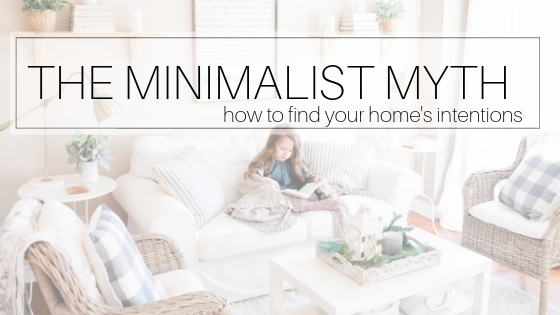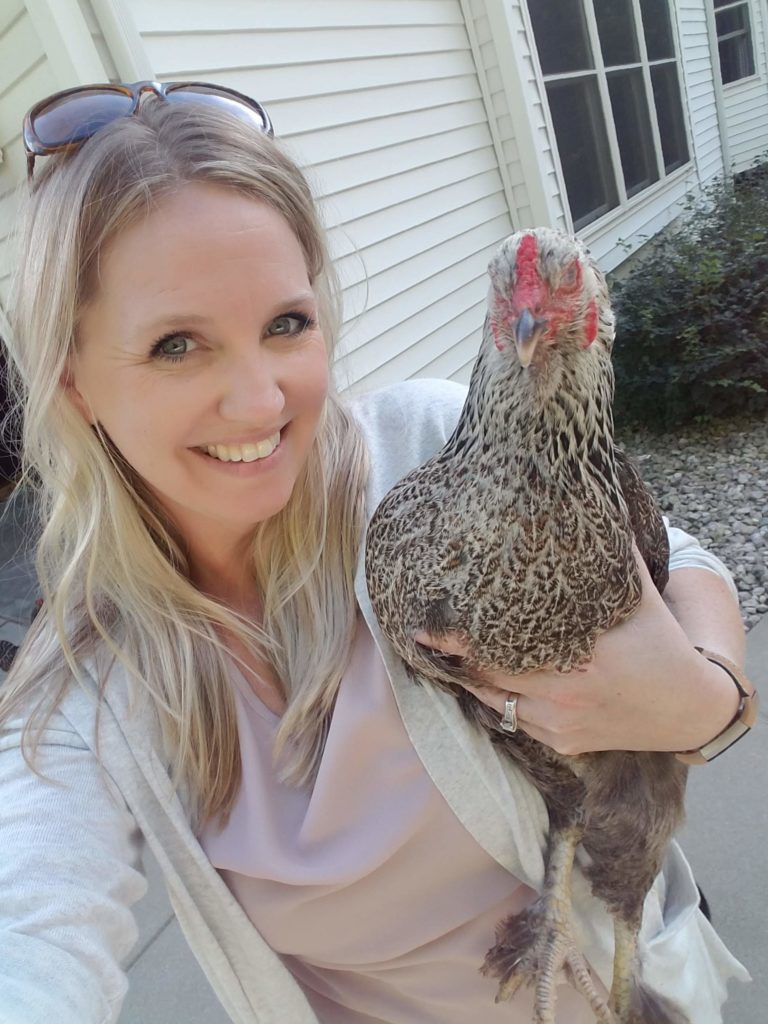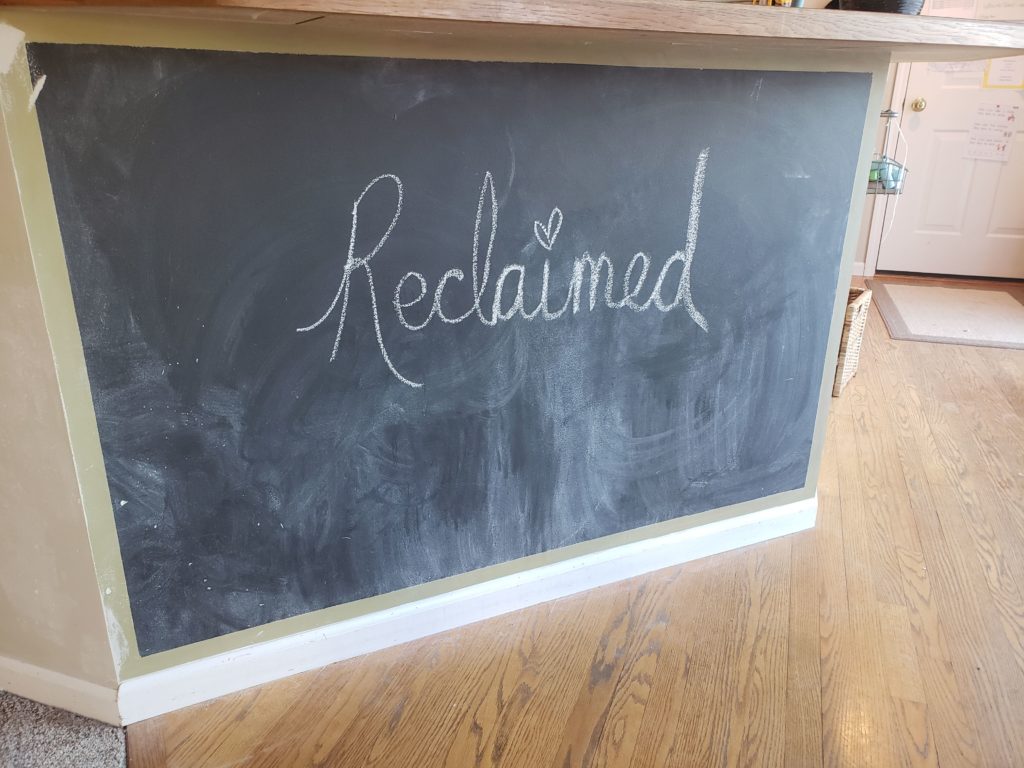The Minimalist Myth

Minimalism. When we hear that word, it might conjure up thoughts of stark white walls and furniture and homes that feel empty and uninviting. This is definitely what I thought of when I read about someone becoming a minimalist. Don’t even get me started on capsule wardrobes! (Though I have shrunk mine considerably! Read more about that here) This is what I call the Minimalism Myth. Because living in minimalism simply means living with what’s enough for YOU.
We can still embrace the joys of living minimally without feeling like our home needs to be either stark or perfect. I am the first to admit how much I LOVE those beautiful pictures of homes that are all white, with their fluffy white rugs and blankets and minimal black and white buffalo plaid pillows and beautiful wood floors – but let’s talk reality for a minute.
- I have kids.
- I have THREE kids
- They actually live in my house
- We actually do life here
- I have pets
- I have pets with fur
- I have chickens too, but that’s a whole other story!

I heart Pinterest
Another sneak peek into my soul: I kinda love Pinterest. I’m guessing you might too. And I love perusing all the ideas of what my dream home will look like and I pin all those beautiful photos of all those perfectly curated rooms and then I close the app and look around my own home. But, what I feel now differs immensely from what I used to feel after an inspirational pinning session.
Before I discovered what I was truly searching for, closing that app meant a forceful push back into reality. A reality where my home had flooring I didn’t love, a kitchen that was too small and light fixtures that were outdated. So often I felt my home left me dissatisfied and ultimately unfinished. I believed that I could not truly enjoy or love my home until it was perfect. But, what does a perfect home really mean? In my mind, it was a beautiful open concept kitchen, distressed wooden floors throughout and beautiful lightly colored furniture that my kids never eat on or jump on.
So here I was living in complete hypocrisy – I wanted a child-friendly home and couches my kids would never go near.
My actual reality
In reality, I knew that when we moved into our current home the most important thing in my ‘design’ would be that it was child-friendly and useable. At the time I didn’t understand words like ‘cozy’ or ‘minimalist’ and had NO idea what I wanted in my home other than for people to feel at ease here. This meant that I painted a chalkboard wall under my bar height counter so the kids could have a place to draw that was in the main living space. I pictured window benches with baskets for toys and lots of pillows and poufs and soft surfaces that wouldn’t take out the kids as they were running through the house.

None of those other items ever came to fruition. Instead, I’ve lived the last five years in my home not truly learning to appreciate it. But, all of that changed when I had a revelation that shook it all up.
My home didn’t have to be perfect or even close to finished for us to feel at home here. It’s just had to be comfortable and welcoming. It had to serve our needs in our current season and changeable enough to grow with us.
Placeholders
I read once about an idea of “placeholders” and it said that when we want something, like a new couch or dining room table, that we should be okay with a placeholder until we are ready to purchase the item that we really want. The placeholder idea helps us to not only spend wisely but to better understand our needs in our homes.
I really, really, really want a new couch. A big cozy sectional that fits all five of us and the dog on movie nights kind of couch. And since we’ve moved in I’ve really wanted an updated kitchen. One where I don’t have to get on my tiptoes to peek around the corner to see what my kids are up to. And, I’ve swayed between enamored with our marked up, crafted-on kitchen table (that I bought for $20 on Craigslist) and being downright embarrassed by it. But I’ve come to appreciate it as a place holder. So are my couches. So is the kitchen.
We will finally (hopefully) be on a journey for that (fiscally responsible) kitchen remodel and I am beyond happy that we didn’t splurge on things like a new table and couch because their needs, placements, and sizes will likely all change and if we had rushed to a purchase, we’d likely have regretted it.
The real lesson I learned
So it ends up that the real lesson I learned is patience. Patience to wait until I can have what I truly want. Patience that my home doesn’t need to be perfect to love it. (It just needed to be decluttered) Patience with myself when I fall into the “I want it” mode and start disqualifying all the good things my home has to offer, like lots of space and a big yard to roam.
Pinterest has a lot of pretty pictures and there are a lot of minimalist out there who can somehow pull off all that beautiful white decor, but if you’re a mom who lives with kids and pets, the truth is that may not be your reality. Just as I know it’s not mine.
Life happens inside our homes. Joy and sadness. Games get played, movies get watched and juice gets spilled. This is where memories are made, relationships get built and families are raised.
A hope of a perfect home will leave you wanting. It’s a mythical creature that we all hope really exists but deep down we know the truth.
Instead of striving for perfection in our homes, let’s start thinking about the INTENTION of our homes.
- How do we want to feel when we walk in the door? Invited, safe, warm, relaxed?
- How do we want to interact in our home? Do we want space to spread out or rooms to gather in?
- How do we intend to use our homes? Do we want to invite the world in or the would we rather block the world out? (Perhaps, a little of both?)
- What would we like our guests to feel when they spend time with us? Welcomed, secure, loved, accepted?
Please don’t think I am suggesting that our homes can’t or shouldn’t be well-kept, un-cluttered or beautiful. I believe all of those things, but I have also lived through the seasons in my home so I know that it won’t always be the case.
We’ve been through the newlywed season when we were excited to make our home our own and lived in continuous projects.
The new motherhood season, when all that mattered was snuggling and nursing my baby (three times over now). Laundry didn’t matter and new curtains didn’t matter. A cozy chair near a window and a snuggly blanket took precedence over everything else.
We’re now living through growing children and changing needs, causing us to rethink our organization methods and needs and knowing that just because it worked before, doesn’t mean it is working now. Our patience has allowed us the ability to let our home grow with us.
And for a LONG time, we lived in a season of chaos when I had no idea that I was allowing my life to run away with me and I felt overwhelmed and stressed. My home was always messy and cluttered and frustrating.
And now we’ve settled into a season of calm. Of knowing what we want from our space and being patient with the time it will take to achieve it.
This book really helped me to understand what I need in my home to create the feeling I am looking for:
What feeling does your home give you?
What season are you in?
Are you able or willing to push past it into a new one? We can’t always move quicker – when our babies are born or when we are in a busy season in our careers, our attention must go elsewhere. But we can create pockets of calm in our home while we practice our patience and wait or slowly pull ourselves into the next season.
So today, take a moment to think about what your home makes you feel and how you would like it to serve you. What can you change to get there? What areas make you feel anxious and unwelcomed. Where do you feel calm and happy?
Where can you create a pocket of intentional simplicity? A quiet room. A beautiful space that you can unwind in. Dream in. Rock your child to sleep in?
When we know how we want to live in our homes and how we’d like our home to serve us, we can begin to appreciate it for the refuge it’s meant to be. If you are ready to make your home a place where you feel relaxed and happy but you aren’t sure where to start, check out this guide to help you answer that question.
I would love to hear about what intentions you want to set for you home! Leave me a comment below or connect with me and the Reclaimed community on the Facebook page.

